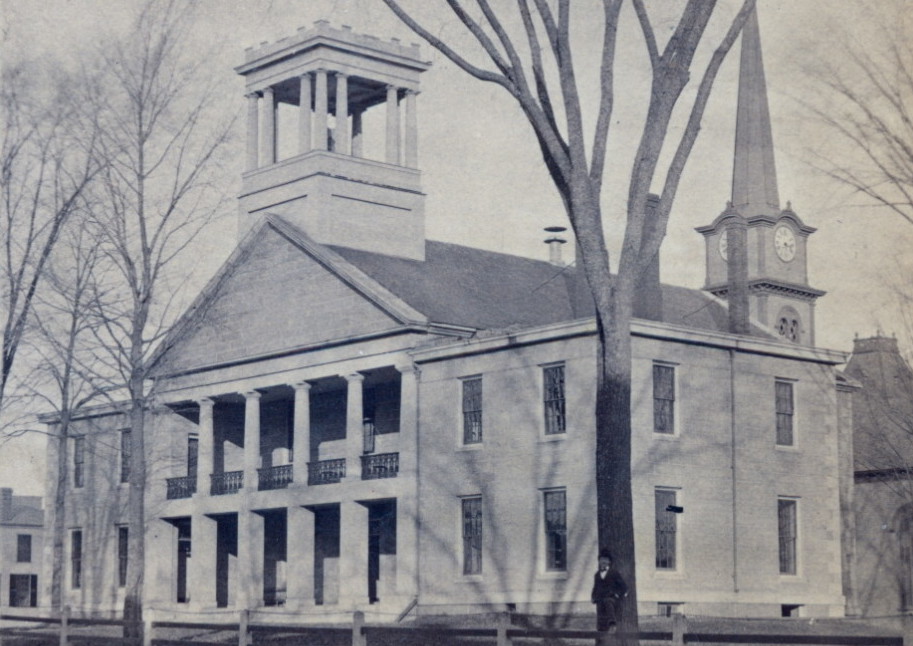Construction on the first courthouse — near Market Square on Winthrop Street — began in 1790, when Augusta, then known as Harrington, had a population of just under 2,000. It was opened in 1802.
But as the population grew and courts got busier and housed more offices, a new stone or granite building was envisioned for the Kennebec Court of General Sessions of the Peace.
The 50-foot by 60-foot by 30-foot granite Greek revival-style building, described as relatively spartan, was designed by James Cochran. It was erected at the Court Street (later renamed State) and Winthrop Street location on land acquired from Nathaniel Hamlen for $1,000, according to a 2012 report by Sutherland Conservation & Consulting.
Some of the earliest views of the structure show the steeple of the 1834-1868 First Baptist Church of Augusta on Winthrop Street in the background.
It is not even the earliest courthouse in the area. That title is held by the wooden, three-story 1761 Pownalborough Court House farther south along the Kennebec River in Dresden.
The Kennebec County Courthouse opened in June 1830 and has been expanded several times since then, first by the addition of two wings and a bell tower in 1851 and later by the Probate Court annex in 1907.
One of the earliest notorious cases in the Kennebec County Courthouse was the trial of Joseph J. Sager of Gardiner, who was accused of poisoning his much-older wife by putting arsenic in her wine at breakfast. The wheels of justice moved swiftly in that instance.
She died on Oct. 5, 1834. He was arrested and indicted almost immediately. A jury convicted Sager of murder on Oct. 19, and he was hanged Jan. 2, 1835, on a gallows erected on Winthrop Street, and in sight of thousands, according to the recitation of the events in James W. North’s “The History of Augusta.”
The courthouse grounds also were the site of funeral obsequies or rites on April 19, 1865, marking the death of President Abraham Lincoln. Government officials, local citizens and fire companies paraded to the courthouse to hear prayers offered by rectors from various churches and a chaplain from Cony United States General Hospital.
In 1885, a sewerage system was installed “and the disagreeable noxious gases which permeated the first floor have been obviated,” as quoted in the Portland Daily Press.
In 1974, the county courthouse was added to the National Register of Historic Places.
Today, Kennebec County Courthouse has a new sign on the front lawn indicating that it houses the Kennebec County Probate Court, the Probate Registry and the Kennebec County District Attorney’s Office.
Visitors to the building will continue to use the main entrance, the double glass doors on the portico, to reach those offices.
However, public access to the second floor of the building is only through the new Capital Judicial Center and via what will be two glassed-in bridges.
Construction on those and other improvements to the building will take place through the summer.
Also relatively new to the front lawn of the county courthouse is a statue of a seated Melville Weston Fuller, who was born in Augusta and sworn in to the bar inside the courthouse. He was nominated to the U.S. Supreme Court by President Grover Cleveland in 1888 and spent more than 21 years as the nation’s top judge before dying at age 77 on July 4, 1910.
Betty Adams — 621-5631
Twitter: @betadams
Copy the Story LinkSend questions/comments to the editors.




Success. Please wait for the page to reload. If the page does not reload within 5 seconds, please refresh the page.
Enter your email and password to access comments.
Hi, to comment on stories you must . This profile is in addition to your subscription and website login.
Already have a commenting profile? .
Invalid username/password.
Please check your email to confirm and complete your registration.
Only subscribers are eligible to post comments. Please subscribe or login first for digital access. Here’s why.
Use the form below to reset your password. When you've submitted your account email, we will send an email with a reset code.